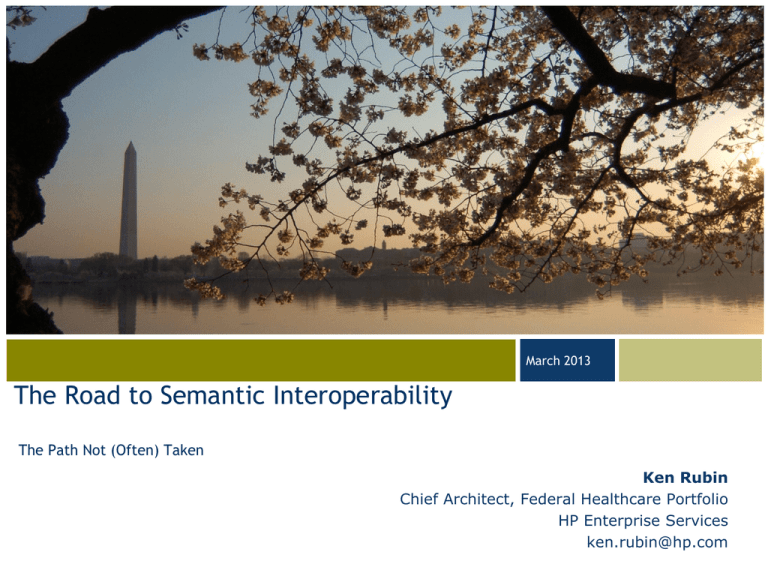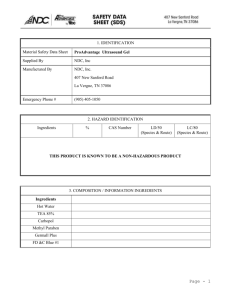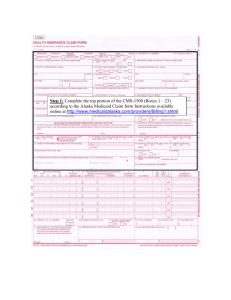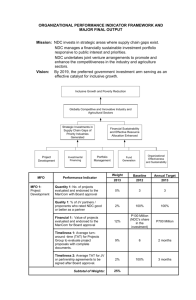
March
2013
03-23-05
The Road to Semantic Interoperability
The Path Not (Often) Taken
Ken Rubin
Chief Architect, Federal Healthcare Portfolio
HP Enterprise Services
ken.rubin@hp.com
Disclaimers
The information that follows is derived from either public
information or personal experience. This information is a goodfaith representation, and every effort has been made to assure
its accuracy, currency, and vendor/product neutrality.
Nonetheless, these slides do not necessarily reflect the official
position of HP, HL7, the US Government, the Veterans Health
Administration, or any organizational affiliation.
The Road to Semantic Interoperability
March 2013
Content in the presentation may be re-used so long as
attribution is provided. All rights reserved.
page 2
Understanding the Business Challenge
The Road to Semantic Interoperability
March 2013
Content in the presentation may be re-used so long as
attribution is provided. All rights reserved.
page 3
A Little Background about Healthcare
• Healthcare is casually referred to as the “Trillion-dollar
Cottage Industry”, spanning geography, organizational
boundaries, languages, cultures
• Healthcare is collaborative
• Health is an incredibly complex domain (more on this later!)
• Health lags significantly behind other market sectors in %
investment in IT, though the gap is narrowing
• The Health IT (HIT) Landscape is largely dominated by a
select number of well established vendors
• HIT challenges are global; no country has this solved
(though some are closer than others)
The Road to Semantic Interoperability
March 2013
Content in the presentation may be re-used so long as
attribution is provided. All rights reserved.
page 4
So why the push for interoperability?
• When was the last time you went to see a doctor?
• Were you asked for your allergies?
• Were you asked about your medical history?
• Were you asked about your current medications?
• How confident are you that you remembered every medication?
• What about your loved ones? An aging parent?
• Have you ever brought a prescription slip to a pharmacy?
• Do you know if any of your over-the-counter medications interact
with your prescriptions?
• When was your last Hep-A booster? Tetanus?
The Road to Semantic Interoperability
March 2013
Content in the presentation may be re-used so long as
attribution is provided. All rights reserved.
page 5
So, What is Interoperability?
Quiz time. Are you interoperable if…
– …you receive data that can be manually keyed or scanned into
you system?
– …batch extracts of data can be received and used on a periodic
basis?
– …you are able to write an adapter to interchange with a
business partner’s IT system?
– …you use accepted industry standard wire protocols?
– …you can receive and ingest an XML document on-demand
(real-time, or near real-time) from a business partner into
your system?
– …you use Web Services?
The Road to Semantic Interoperability
March 2013
Content in the presentation may be re-used so long as
attribution is provided. All rights reserved.
page 6
What is semantic interoperability?
Quiz time. Are you interoperable if…
– … you lack processes to validate accuracy of data entry?
– …data is represented differently across systems within your
organization
– … you and your business partners use different codes?
– … you and your business partners use the same codes, but
use them differently?
– …you use standardized codes to represent data, but allow
localized extensions?
The Road to Semantic Interoperability
March 2013
Content in the presentation may be re-used so long as
attribution is provided. All rights reserved.
page 7
So, let’s contrast “IT” with “HIT”
• A typical info system …
• A typical healthcare IT system…
– Supports the need for
persistence
– Impacts life-or-death decisions,
literally.
– Is designed to meet
performance requirements
– Has extreme high-availability
requirements
– Supports concurrency,
scalability
– Has Near-real-time performance
expectation
– Is designed by a DBA in
conjunction with a project
team
– Must be capable of integrating
content from external sources
– Are closely coupled with the
application it supports
– Has a usable system life of
2-10 years
The Road to Semantic Interoperability
– Extreme sensitivity to privacy and
security considerations
– Must maintain data access for the
lifetime of the patient (or longer!)
March 2013
Content in the presentation may be re-used so long as
attribution is provided. All rights reserved.
page 8
Real Requirements for an Electronic Health Record…
• Capable of integrating data from our business partners
and patients themselves
• Data from business partners must maintain consistency in
its meaning
• Manage approximately 3000 unique data elements in 14
functional domains (laboratory, pharmacy, vitals,
demographics, encounters, radiology/nuclear medicine,
etc.)
• Provide medical alerts for approximately 500k drug-drug
and drug-allergy interactions and contraindications
• Maintain data integrity for 75-years post mortem of
patient (up to 150 years) retaining durable meanings
The Road to Semantic Interoperability
March 2013
Content in the presentation may be re-used so long as
attribution is provided. All rights reserved.
page 9
Tackling This Challenge…
Key Solution Elements
The Road to Semantic Interoperability
March 2013
Content in the presentation may be re-used so long as
attribution is provided. All rights reserved.
page 10
Role of an Information Model
• Establishes a basis for harmonizing and standardizing
semantics
• Clarifies data typing
• Determines bindings to relevant terminologies
• Assures consistent information representation
• To depict structure and semantic relationships supporting
(among other things)
• Provides guidance for logical database design
• Provides basis for message payload (e.g., interface
parameters)
The Road to Semantic Interoperability
March 2013
Content in the presentation may be re-used so long as
attribution is provided. All rights reserved.
page 11
Understanding Terminology 101
• Terminology (or ontology) is a structured representation of
data
• Terminology is needed to allow for data comparability and
consistency
• Formal terminologies are based on concept codes that
themselves have no inherent meaning
• Key to this principle is to distinguish the concept itself
from the label
• Just because you have a common label (known as “surface
form”) doesn’t mean you have a shared understanding
• Let me show you what I mean…
The Road to Semantic Interoperability
March 2013
Content in the presentation may be re-used so long as
attribution is provided. All rights reserved.
page 12
Understanding Terminology 201
Same concept,
different “surface form”
Biblioteca Medellin, photo taken from Wikipedia
•Library of Congress image from visitingdc.com website
•Both photos believed to be in the public domain
The Road to Semantic Interoperability
March 2013
Content in the presentation may be re-used so long as
attribution is provided. All rights reserved.
page 13
Understanding Terminology 301
Same “surface form”, different concepts
Salmon photo courtesy of Carly & Art, via Flicker,
Creative Commons License
•Potato Skins photo courtesy of Scorpions and Centaurs,
Creative Commons License
The Road to Semantic Interoperability
March 2013
Content in the presentation may be re-used so long as
attribution is provided. All rights reserved.
page 14
Understanding Terminology 401
Same surface form, different concepts
First photo courtesy of avlxyz, via Flicker,
Creative Commons License
Second photo taken from The Coffee Club (Australia) Website
The Road to Semantic Interoperability
March 2013
Content in the presentation may be re-used so long as
attribution is provided. All rights reserved.
page 15
So Let’s Explore “Computable” Data…
Not all data representations are created equal
• Content stored as strings without an underlying
terminology cannot be used for [clinical] reasoning, alerts,
interactions, epidemiology
• Adherence to data constraints (e.g. 1000/500?)
• A simple example: how many genders are there?
• A VHA example: getting to Yes
• The effort and importance of knowledge engineering and
terminology cannot be overstated
The Road to Semantic Interoperability
March 2013
Content in the presentation may be re-used so long as
attribution is provided. All rights reserved.
page 16
A Simple example: “Yes-No” Codes
(slide adapted from VHA)
• The Standard Terminology Model for a collaborative across the US
Federal Health programme reviewed “Yes-No” Code sets
• Identified were 3396 instances of “Yes-No” use in DoD, VA and IHS
• There were 30 unique ways to say it
• E.g. Yes = 1 No = 2
• E.g. Yes = 0 No = 1 etc etc
The Road to Semantic Interoperability
March 2013
Content in the presentation may be re-used so long as
attribution is provided. All rights reserved.
page 17
LOINC for Hgb A1c
•
HEM 4547-6 HEMOGLOBIN A1/HEMOGLOBIN.TOTAL SFR PT BLD QN HAEMOGLOBIN A1
19980618 NAM
•
HEM 4548-4 HEMOGLOBIN A1C/HEMOGLOBIN.TOTAL SFR PT BLD QN
HGB;HAEMOGLOBIN;GLYCATED;GLYCOSYLATED 20000322 MIN A02540 16500 QU60433
•
HEM 17855-8 HEMOGLOBIN A1C/HEMOGLOBIN.TOTAL SFR PT BLD QN CALCULATED
HGB;HAEMOGLOBIN;GLYCATED;GLYCOSYLATED20000322 MIN
•
HEM 4549-2 HEMOGLOBIN A1C/HEMOGLOBIN.TOTAL SFR PT BLD QN
ELECTROPHORESIS HGB;HAEMOGLOBIN;GLYCATED;GLYCOSYLATED 19980618 NAM
A02540 16500 QU60433
•
HEM 17856-6 HEMOGLOBIN A1C/HEMOGLOBIN.TOTAL SFR PT BLD QN HPLC
HGB;HAEMOGLOBIN;GLYCATED;GLYCOSYLATED 20000322 MIN
•
HEMOGLOBIN.GLYCATED PT BLD QN HEMOGLOBIN
GLYCOSYLATED;GLYCOHEMOGLOBIN; GLYCOHAEMOGLOBIN;HAEMOGLOBIN.
GLYCATED;HAEMOGLOBIN GLYCOSYLATED 19980618 DEL 16500 MSH94D0 06454
The Road to Semantic Interoperability
March 2013
Content in the presentation may be re-used so long as
attribution is provided. All rights reserved.
page 18
NDC: 46193073801
NDC: 00686027720
NDC: 00555046506
NDC: 48695117305
NDC: 00555046505
NDC: 00047007032
NDC: 00555046502
NDC: 00047007024
NDC: 00054475833
NDC: 00223255002
NDC: 00054475831
NDC: 00223255001
NDC: 00054475825
NDC: 00364075690
NDC: 54441019750
NDC: 00364075602
NDC: 54441019725
NDC: 00364075601
NDC: 54441019715
NDC: 52953000304
NDC: 54441019711
NDC: 00378018210
NDC: 54441019710
NDC: 00378018201
NDC: 00182175810
NDC: 51432097106
NDC: 00182175801
NDC: 00677104110
NDC: 00228232796
NDC: 00677104105
NDC: 00228232710
NDC: 00677104101
NDC: 00046042199
NDC: 54569055650
NDC: 00046042198
NDC: 00102333502
NDC: 00046042195
NDC: 46193073810
NDC: 00603548921
NDC: 46193073805
NDC: 53258015313
NDC: 52544030505
NDC: 54269010901
NDC: 52544030501
NDC: 51813007299
NDC: 53633032116
NDC: 51813007290
NDC: 53633032110
NDC: 51813007260
NDC: 12071044010
NDC: 53492301303
NDC: 54441004350
NDC: 53492301302
NDC: 54441004325
NDC: 53492301301
NDC: 54441004310
NDC: 00591555404
NDC: 54441004305
NDC: 00591555401
NDC: 54441004301
NDC: 52493063960
The Road
to Semantic Interoperability
NDC:
49884010610
NDC: 00839711420
NDC: 49884010605
NDC: 51285032190
NDC: 51285032160
NDC: 52985003606
NDC: 52985003601
NDC: 51285032112
NDC: 51285032109
NDC: 51285032105
NDC: 51285032102
NDC: 00555036505
NDC: 00555036502
NDC: 00308627099
NDC: 00308627060
NDC: 00308627030
NDC: 54697006301
NDC: 00302573210
NDC: 11146091299
NDC: 00719179413
NDC: 00719179410
NDC: 00904041180
NDC: 00904041160
NDC: 00894633104
NDC: 00894633103
NDC: 00894633102
NDC: 00894633101
NDC: 10647042101
NDC: 50111046707
NDC: 50111046703
NDC: 50111046701
NDC: 52555001010
NDC: 52555001001
March 2013
NDC: 00093060010
NDC: 00093060001
NDC: 50053310901
NDC: 00615256113
NDC: 47679070204
NDC: 40039006001
NDC: 47679070201
NDC: 00025090152
NDC: 46703009410
NDC: 00025090131
NDC: 46703009401
NDC: 47202255103
NDC: 52584018410
NDC: 47202255101
NDC: 00363690810
NDC: 12027008902
NDC: 53489045101
NDC: 12027008901
NDC: 00157052610
NDC: 53487014510
NDC: 00157052601
NDC: 00781134413
NDC: 00054875825
NDC: 00781134410
NDC: 00005310931
NDC: 00781134401
NDC: 00005310923
NDC: 53978003410
NDC: 00071007024
NDC: 00117134405
NDC: 00046042191
NDC: 00117134401
NDC: 00046042181
NDC: 51316009004
NDC: 00046042180
NDC: 11146094210
NDC: 00046042162
NDC: 52544030551
NDC: 00046042161
NDC: 52544030510
NDC: 00046042160
NDC: 00839711416
NDC: 00814644630
NDC: 00536430910
NDC: 54697006305
NDC: 00536430905
NDC: 54697006304
NDC: 00536430901
NDC: 54697006303
NDC: 35470050801
NDC: 54697006302
NDC: 00143150225
NDC: 49884010601
NDC: 51608042104
NDC: 00686018201
NDC: 51608042102
NDC: 51079027760
NDC: 10465042109
NDC: 00349845190
NDC: 00721002301
NDC: 00349845110
NDC: 54421011001
Content in the presentation may be re-used so long as
page 19
attribution
is provided. All rights reserved.
NDC: 00349845101
NDC: 19458042007
NDC: 50053310902
NDC: 19458042001
NDC: 00179038202
NDC: 00179038201
NDC: 54738046703
NDC: 54738046701
NDC: 00182181289
NDC: 00603548932
NDC: 46193073801
NDC: 00686027720
NDC: 00555046506
NDC: 48695117305
NDC: 00555046505
NDC: 00047007032
NDC: 00555046502
NDC: 00047007024
NDC: 00054475833
NDC: 00223255002
NDC: 00054475831
NDC: 00223255001
NDC: 00054475825
NDC: 00364075690
NDC: 54441019750
NDC: 00364075602
NDC: 54441019725
NDC: 00364075601
NDC: 54441019715
NDC: 52953000304
NDC: 54441019711
NDC: 00378018210
NDC: 54441019710
NDC: 00378018201
NDC: 00182175810
NDC: 51432097106
NDC: 00182175801
NDC: 00677104110
NDC: 00228232796
NDC: 00677104105
NDC: 00228232710
NDC: 00677104101
NDC: 00046042199
NDC: 54569055650
NDC: 00046042198
NDC: 00102333502
NDC: 00046042195
NDC: 46193073810
NDC: 00603548921
NDC: 46193073805
NDC: 53258015313
NDC: 52544030505
NDC: 54269010901
NDC: 52544030501
NDC: 51813007299
NDC: 53633032116
NDC: 51813007290
NDC: 53633032110
NDC: 51813007260
NDC: 12071044010
NDC: 53492301303
NDC: 54441004350
NDC: 53492301302
NDC: 54441004325
NDC: 53492301301
NDC: 54441004310
NDC: 00591555404
NDC: 54441004305
NDC: 00591555401
NDC: 54441004301
NDC: 52493063960
The Road
to Semantic Interoperability
NDC:
49884010610
NDC: 00839711420
NDC: 49884010605
NDC: 51285032190
NDC: 51285032160
NDC: 52985003606
NDC: 52985003601
NDC: 51285032112
NDC: 51285032109
NDC: 51285032105
NDC: 51285032102
NDC: 00555036505
NDC: 00555036502
NDC: 00308627099
NDC: 00308627060
NDC: 00308627030
NDC: 54697006301
NDC: 00302573210
NDC: 11146091299
NDC: 00719179413
NDC: 00719179410
NDC: 00904041180
NDC: 00904041160
NDC: 00894633104
NDC: 00894633103
NDC: 00894633102
NDC: 00894633101
NDC: 10647042101
NDC: 50111046707
NDC: 50111046703
NDC: 50111046701
NDC: 52555001010
NDC: 52555001001
March 2013
NDC: 00093060010
NDC: 00093060001
Propranolol
10Mg Tab
NDC: 50053310901
NDC: 00615256113
NDC: 47679070204
NDC: 40039006001
NDC: 47679070201
NDC: 00025090152
NDC: 46703009410
NDC: 00025090131
NDC: 46703009401
NDC: 47202255103
NDC: 52584018410
NDC: 47202255101
NDC: 00363690810
NDC: 12027008902
NDC: 53489045101
NDC: 12027008901
NDC: 00157052610
NDC: 53487014510
NDC: 00157052601
NDC: 00781134413
NDC: 00054875825
NDC: 00781134410
NDC: 00005310931
NDC: 00781134401
NDC: 00005310923
NDC: 53978003410
NDC: 00071007024
NDC: 00117134405
NDC: 00046042191
NDC: 00117134401
NDC: 00046042181
NDC: 51316009004
NDC: 00046042180
NDC: 11146094210
NDC: 00046042162
NDC: 52544030551
NDC: 00046042161
NDC: 52544030510
NDC: 00046042160
NDC: 00839711416
NDC: 00814644630
NDC: 00536430910
NDC: 54697006305
NDC: 00536430905
NDC: 54697006304
NDC: 00536430901
NDC: 54697006303
NDC: 35470050801
NDC: 54697006302
NDC: 00143150225
NDC: 49884010601
NDC: 51608042104
NDC: 00686018201
NDC: 51608042102
NDC: 51079027760
NDC: 10465042109
NDC: 00349845190
NDC: 00721002301
NDC: 00349845110
NDC: 54421011001
Content in the presentation may be re-used so long as
page 20
attribution
is provided. All rights reserved.
NDC: 00349845101
NDC: 19458042007
NDC: 50053310902
NDC: 19458042001
Designing for
Interoperability
Ability to Interoperate
High
Low
The Road to Semantic Interoperability
March 2013
Content in the presentation may be re-used so long as
attribution is provided. All rights reserved.
page 21
Localization Concept: The Virtual Boundary
• External Standards
•Legacy Applications
Organizational Compliance
- Organizational Semantics (Info Model)
- Integration compliance (SOA services)
- Governance
The Road to Semantic Interoperability
March 2013
Content in the presentation may be re-used so long as
attribution is provided. All rights reserved.
page 22
Semantic Support in HIT Standards…
V2
Msgs
V3
Msgs
CDA Services
Data Descriptions are Explicit
•
Behavior is Explicit
•
•
Has medico-legal Meaning
•
•
Provides clinical context
•
Allows customization/extensibility
•
•
•
•
Allows for ontologically-based data
Allows for non-ontologically-based data
Provides for self-discovered semantics
The Road to Semantic Interoperability
March 2013
•
Content in the presentation may be re-used so long as
attribution is provided. All rights reserved.
* Dependent upon implementation or us
The Road to Semantic Interoperability
March 2013
Content in the presentation may be re-used so long as
attribution is provided. All rights reserved.
page 24
Enterprise Architecture
The Pragmatists View
• Done correctly, EA establishes the target
to which the organization is heading
• EA models typically address business,
information, and technology views
• An EA program establishes a “source of
truth” for standards
• More importantly, the EA specifies not
just stds & technologies are to be used,
but how
• EA is only effective when supporting and
engaging stakeholders, and where the
program has governance authority
The Road to Semantic Interoperability
March 2013
Content in the presentation may be re-used so long as
attribution is provided. All rights reserved.
page 25
EASE ON DOWN THE ROAD…
The Road to Semantic Interoperability
March 2013
Content in the presentation may be re-used so long as
attribution is provided. All rights reserved.
3/20/2013
26
First Stop: Version Management
Why include it?
How to approach it:
• EVERYTHING is going to
change, that includes:
•
Apply a formal, rigorous approach to
version management (perhaps the
MOST IMPORTANT element in
managing continuous change)
•
Every time something is deployed that
is changed, version it. Not just
software, but also information assets
•
Understand and get religious about
dependency management
•
Be very cautions and judicious about
any “physical” deletes
– The data and the structures
containing it
– The expectations of the data
– The terminology(ies)
– The interfaces
– The applications
The Road to Semantic Interoperability
March 2013
Content in the presentation may be re-used so long as
attribution is provided. All rights reserved.
01/01/2011
27
Second Stop: Legacy Enablement
Why include it?
How to approach it:
• Investment in current
systems and infrastructure is
too significant to ignore or to
start ‘green field’
• Use EA to determine system
role, especially where its data
is the “authoritative source”
• Neither business case nor
organizational ‘will’ (not to
mention budget) exists to
replace all of your existing IT
• New infrastructure will need
to more effectively interact
with legacy
The Road to Semantic Interoperability
• Review information exchange
needs within and outside of the
organization
• Map current messaging and
interfaces into logical
information constructs
• “Service-enable” the legacy by
adding request/response
interfaces carrying structured
payload (e.g., SOA)
March 2013
Content in the presentation may be re-used so long as
attribution is provided. All rights reserved.
01/01/2011
28
Third Stop: Foster Peaceful Co-Existence of Structured and
Unstructured Data
Why include it?
Key Solution Considerations
• Health today significantly
depends on unstructured data
• Consider structured information
with the end objectives in mind
(e.g., clinical quality, process
improvement, epidemiology)
• Huge push worldwide to
move to structured
information (SNOMED, ICD10/11)
• Structured information offers
many benefits (e.g.,
analytics, comparability,
decision-support), but
• TCO of structured information
must consider organizational
adoption (staff training,
quality/oversight processes, etc.)
• User experience is of paramount
importance
• Structured information does
not come ‘free’
The Road to Semantic Interoperability
March 2013
Content in the presentation may be re-used so long as
attribution is provided. All rights reserved.
01/01/2011
29
Fourth Stop: Metadata Management
Why include it?
Key Solution Considerations
• As information interchange
increases, data content will
increasingly come from
multiple sources
• Note that metadata describes what
is in the “container”, allowing the
recipient to comprehend what they
received
• Today, metadata
management is done
implicitly based upon source
(e.g. “This record is from the
xxxx General Hospital”)
• Use models based on ontologically
as the basis for your metadata
• We will never see ubiquity of
data representation and use
(e.g., variance is here to
stay)
The Road to Semantic Interoperability
• Version management applies to
metadata too
• Allow for discovery via use of
[public] registries
March 2013
Content in the presentation may be re-used so long as
attribution is provided. All rights reserved.
01/01/2011
30
Final Stop: Context Management
Why include it?
Key Solution Considerations
• Information structures are
an implicit component of
healthcare and used in
business terms today (e.g.,
“Blood Pressure Reading”,
“Discharge Summary”,
etc.)
• Thoughtful units of composition
• As [clinical] information
flow grows, receipt of
standalone data items is
insufficient
• Applied metadata management
• Ability for constructs to retain
medico-legal meaning
• Seek out existing sources for
representing contextual elements
(structure-oriented standards)
• Current transport model
either predicates that the
sender “knows” what the
recipient will need, or that
the recipient will “know”
what to ask for
The Road to Semantic Interoperability
March 2013
Content in the presentation may be re-used so long as
attribution is provided. All rights reserved.
01/01/2011
31
RELEVANT WORK
The Road to Semantic Interoperability
March 2013
Content in the presentation may be re-used so long as
attribution is provided. All rights reserved.
3/20/2013
32
Asset Inventory
Asset
What it is for
Common
Terminology Service
(CTS II)
Establish a standards-based way of interacting
with and managing complex coding systems
and vocabularies.
Defines interfaces for the storage, management,
and maintenance of terminology
API for
Knowledgebases
(API4KB)
Integrates various reasoning systems in a
loosely coupled, hybrid environment, to allow
complex sets of services to be developed and
combined.
Defines APIs for Parsing,. Reasoning, Persistent
Storage, Queries, Rules and query of metadata to
understand the capabilities of the service offering
behind the API
Ontology Definition
Metamodel (ODM)
Bridges traditional UML modeling and software
engineering popular ontology languages, (RDF,
RDF /S), the Web Ontology Language (OWL),
Topic Maps (TM), and Common Logic (CL).
Supports interchange and management of
vocabularies and ontologies with MOF/XMI tools
and repositories, as well profiles and graphical
representation for developing vocabularies and
ontologies in UML tools
Retrieve Locate
Update Service
(RLUS)
To manage location and retrieval of healthcare
content
Defines an abstract service interface for create,
read, update, delete functions
hDATA RESTful
Transport Specification
REST binding for data retrieval using SOA
(RLUS for REST)
Provides a REST binding for create, read, update,
delete functions
Clinical Decision
Support Service (DSS)
To analyze patient data / assess knowledge
rules.
Establish interface for passing in patient data and
returning relevant clinical protocol
hDATA Record Format
Specification
A hierarchical format with metadata tagging for
organizing / representing [clinical] data
Provides a superstructure into which [clinical] data
can be slotted and transported.
The Road to Semantic Interoperability
What it does
March 2013
Content in the presentation may be re-used so long as
attribution is provided. All rights reserved.
page 33
Acknowledgements
Several of these slides have been shamelessly borrowed
from the Healthcare Services Specification Project, a joint
standards collaboration between OMG and Health Level
Seven (HL7)
Their slideware licensing allows reuse with attribution.
This is attribution
The Road to Semantic Interoperability
March 2013
Content in the presentation may be re-used so long as
attribution is provided. All rights reserved.
page 34
Thank you!
Ken Rubin
Chief Architect, Federal Healthcare
ken.rubin@hp.com
The Road to Semantic Interoperability
March 2013
Content in the presentation may be re-used so long as
attribution is provided. All rights reserved.
page 35




